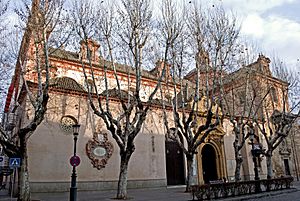Santa María Magdalena, Seville facts for kids
The Santa María Magdalena Church is a beautiful old church located in Seville, a city in southern Spain. It was built in a style called Baroque, which means it has lots of fancy decorations and dramatic designs. Construction on the church happened between 1691 and 1709. The main architect who designed it was Leonardo de Figueroa.
This church is also home to several hermandades. These are like special groups or brotherhoods that are famous for taking part in religious parades and celebrations in Seville.
Contents
History of Santa María Magdalena Church
This church was originally built for a group of monks called the Dominicans. It was part of their monastery. Before this church, there was an older, medieval building on the same spot. That older building was constructed after Christians took control of Seville in 1248.
Later, in the 1800s, the monastery closed down. After that, the Santa María Magdalena Church became a regular church for the local community. It is now known as a "parish church."
Exploring the Church's Architecture
The outside of the Santa María Magdalena Church is very striking. It has three main entrances, called portals. One of these portals features a sculpture of "St. Dominic" created by the artist Pedro Roldán.
Exterior Design and Features
Above the main entrances, you can see a round window called an oculus. On each side of this window are two blue spheres. These spheres are symbols related to the mystery of the rosary, which is a special prayer in Christianity. The church also has a bell-gable, which is a wall with openings for bells. This bell-gable was added in 1697. The entire outside of the church is decorated with many blue and red patterns, making it very colorful.
When you go inside the church, you will find a large central area called a nave. There are also two side sections, known as aisles. The church has a transept, which is a part that crosses the main body of the church, making it look like a cross from above.
There are five chapels inside the church. One of these chapels is very old. It is the only part left from the original medieval building. This chapel belongs to the Hermandad de la Quinta Angustia, which means the Brotherhood of the Fifth Anguish. The church also has a presbytery, which is the area around the main altar.
Dome and Interior Decorations
The main nave of the church is topped by an octagonal dome. On the outside, this dome has decorations that look like figures from the Inca people. The inside of the church is richly decorated in the Baroque style. You'll see many stucco designs and gold-colored details, making it feel very grand.
Artworks and Sculptures
The Chapel of the Dulce Nombre de Jesús (Sweet Name of Jesus) holds more amazing art. It has another work by Pedro Roldán. You can also see a sculpture called Christ Reborn by Jerónimo Hernández here.
The main altar of the church is also in the Baroque style and dates back to the 1700s. It features sculptures by famous artists like Pedro Duque y Cornejo and Francisco de Ocampo. The retable (a large altarpiece) showing the Assumption was made by Juan de Mesa. Other artworks in the church include frescoes by Lucas Valdés and two paintings by Francisco de Zurbarán.
See also
 In Spanish: Iglesia de Santa María Magdalena (Sevilla) para niños
In Spanish: Iglesia de Santa María Magdalena (Sevilla) para niños


